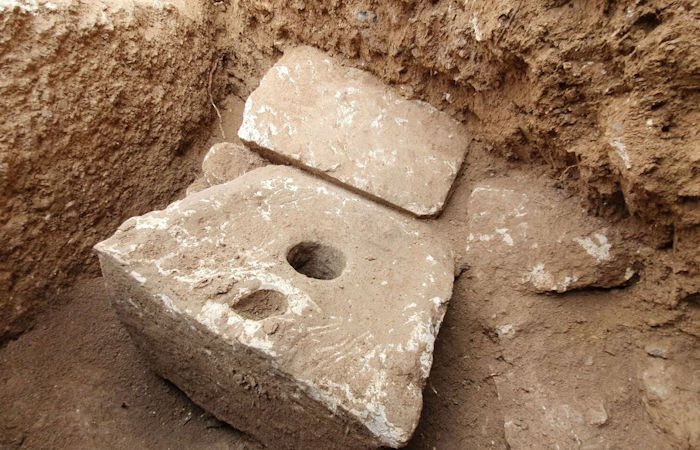Jan Bartek - AncientPages.com - A new study by Tel Aviv University and the Israel Antiquities Authority has exposed the remains of 2,700-year-old intestinal worm eggs below the stone toilet of a magnificent private estate.
The egg remnants belong to four different types of intestinal parasites: roundworm, tapeworm, whipworm, and pinworm. According to the researchers, the stone toilet seat was in the estate's "restroom," and the presence of the worms indicates that even the wealthy residents of Jerusalem at that time suffered from diseases and epidemics.
The study was led by Dr. Dafna Langgut of Tel Aviv University's director of the Laboratory of Archaeobotany and Ancient Environments at the Institute of Archaeology and the Steinhardt Museum of Natural History. Dr. Langgut collected sediment samples from underneath the stone toilet, where the cesspit was located. Next, in her laboratory, she chemically extracted the parasite eggs, scrutinized them under a light microscope, and identified them. The egg remains were discovered as part of a salvage excavation by the Israel Antiquities Authority, recently carried out at the Armon Hanatziv Promenade in Jerusalem.
The 2700-year-old toilet seat made of stone. Credit: Yoli Schwartz, The Israel Antiquities Authority.
"The findings of this study are among the earliest observed in Israel to date," says Dr. Langgut. "These are durable eggs, and under the special conditions provided by the cesspit, they survived for nearly 2,700 years. Intestinal worms are parasites that cause symptoms like abdominal pain, nausea, diarrhea, and itching. Some of them are especially dangerous for children and can lead to malnutrition, developmental delays, nervous system damage, and, in extreme cases, even death."
Dr. Langgut believes that intestinal disease at the time might have been due to poor sanitary conditions that caused fecal contamination of food and drinking water. Or, it might have been due to a lack of hygiene awareness, such as a failure to wash hands. Other possible sources of infection were the use of human feces to fertilize field crops and the consumption of improperly cooked beef or pork. In the absence of medicine, recovery from intestinal worms was difficult to impossible, and those infected could suffer from the parasites for the rest of their lives. Therefore, it is quite possible that the findings of the study indicate a bothersome and long-lasting infectious disease (comparable to lice and pinworms in the kindergartens of today) that affected the entire population. Langgut points out that these parasites still exist today, but the modern Western world has developed effective diagnostic means and medications, so they don't turn into an epidemic.
Ya'akov Billig, the director of the excavation on behalf of the Israel Antiquities Authority, explains that the uncovered royal estate dates back to the mid-7th century BC (the late Iron Age). According to Billig, magnificent stone artifacts of extraordinary workmanship were found at the site, such as decorated stone capitals (in the Proto-Aeolian style) of a quantity and quality not yet observed in ancient Israel. Adjacent to the mansion was a spectacular garden with a breathtaking view of the City of David and the Temple Mount. It was here, along with the remains of fruit and ornamental trees, that the cesspit sampled by Langgut was found. It was capped by a square limestone installation with a hole in its center, identified as a toilet's drop hole. The salvage excavation at Armon Hanatziv was funded by the Ir David Foundation.
For Dr. Langgut, this was an opportunity to apply a field of research called archeoparasitology that she had begun to develop in her laboratory. In this field, researchers identify microscopic remains of intestinal worm eggs to learn about the history of diseases and epidemics. This area provides new information regarding human health, hygiene, lifestyle, and sanitary conditions.
Langgut and Billig were not surprised by the recovery of a toilet in the estate's prestigious garden. "Toilet facilities were extremely rare at that time and were a status symbol—a luxury facility that only the rich and high-ranking could afford. As the Talmud teaches, "Who is wealthy?... Rabbi Yosef says: Anyone who has a bathroom close to his table.'" (Bavli Shabbat 25: 2).
Intestinal parasite eggs recovered from sediment collected below the stone toilet seat at Armon Hanatziv. (a). Enterobius vermicularis; (b). Ascaris lumbricoides; (c). Trichuris suis; (d). Trichuris trichiura; (e). Taenia sp. Each bar = 25 micron. Credit: Eitan Kremer
Eli Escozido, director of the Israel Antiquities Authority, says, "The research conducted by the Israel Antiquities Authority and our partners manages to touch on the finest details of everyday life in antiquity; thanks to advanced equipment and fruitful collaboration with complementary research institutions, it is now possible to extract fascinating information from materials that we previously didn't have the tools to handle scientifically. Today, archeological research is reaching remarkable achievements and leading to a better understanding of past lifeways—an understanding, it seems, that will only continue to evolve."
Dr. Langgut concludes, "Studies like this one help us document the history of infectious diseases in our area and provide us with a window into the lives of people in ancient times." Dr. Langgut is currently conducting additional analyses on the sediments collected from the cesspit in order to learn about the diet and medicinal herbs used in Jerusalem in the late Iron Age.
Written by Jan Bartek - AncientPages.com Staff Writer






